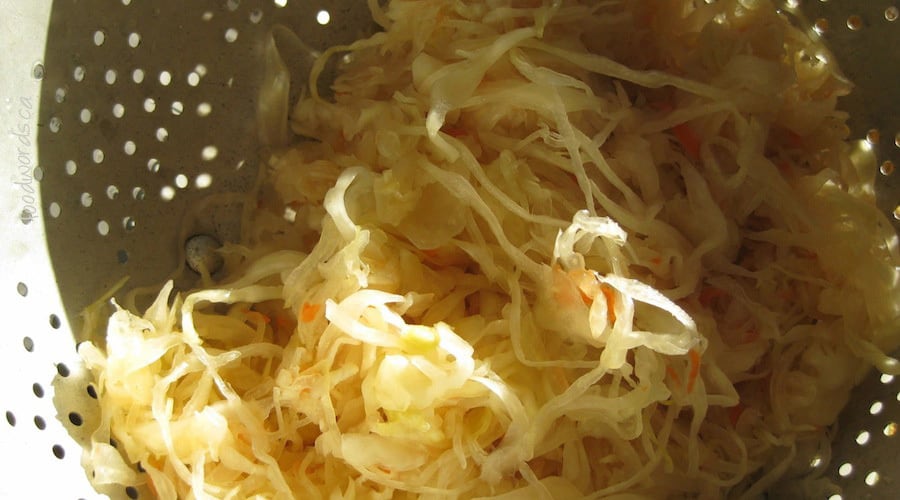Fermented foods like sauerkraut have found a new and appreciative crowd. Perhaps not a big crowd but the health conscious and farm to table types value it for its raw goodness. I’m not sure they would like it otherwise. I’ve always found it to be a hard sell.
My dad would have wondered why it took everybody so long. Growing up, he told us, with faithful regularity, how good sauerkraut was for keeping colds away (like kids are going to pound it down knowing that). But he was annoyingly right; it’s full of vitamin C. And fermented foods, when eaten uncooked, are full of good bacteria, which eat up the bad kind and keep our guts lively and healthy.
Sauerkraut was something that kids with eastern European heritage grew up eating and sometimes making. It had little to do with health and a lot to do with comfort and economics. Cabbages don’t cost a whole lot. My friend, Karin got to live with the festering crock of stinking fermenting cabbage under her bed because her room was the best temperature. Lucky Karin.
In my house, it was an annual event. When the cabbages were ready in the fields my dad was there with an open trunk – a 1956 Plymouth Belvedere has a big trunk. He filled it, brought them home and invited friends over to shred, pound, and salt all the day long – with more than a few Black Label Beers. No vinegar, that’s pickling, he said. He liked the old world method (for his dills, too) even though he was born into the Saskatchewan world. To us kids old world equalled mushy.
Fermentation is a simple process of alchemy, whereby temperature & nurture transform a few ingredients into something pickle-like. So, I’m not sure about the pounding my dad gave the cabbage. The sauerkraut I eat today is nothing soft and smelly like his cabbage juice mess (which he would drink, getting his year’s worth of sodium in one gulp).
Once made, it went into stone crocks and every few days he’d go down to the basement and remove the scuzzy head that was his fermentation in action. When it was done, whenever that was, he bagged it and put it in the freezer. Some years were better than others but mostly it was bad.
Remarkably, I still like sauerkraut, especially now that I know it is something crisp and light. Sometimes it’s made with shredded carrots and sometimes a bit of wine or, gak, even vinegar. One thing for sure, it’s always salty (my dad got that part right) and has to be well rinsed before using.
If you want it raw with all its glorious gut digesting enzymes, make a salad adding other julienned veggies and dress with a mustard or horseradish vinaigrette – 1 tbsp. prepared horseradish, 1 tbsp. white wine vinegar, bit of sugar, 2 tbsp. olive oil (more or less).
In that northern Europe old world way, it’s most commonly used in braised meat dishes, the most famous being choucroute garnie, a wintery, slow cooked dish of smoked pork and sausages from the Alsace region in France. This is faster and good – though my father was scornful of frying sauerkraut and not because it deadend the enzymes but because it tasted ‘wrong’. Fry it in bacon fat with onions and use in a Reuben sandwich.
BESbswyBESbswyBESbswyBESbswyBESbswyBESbswyBESbswyBESbswyBESbswyBESbswyBESbswyBESbswyBESbswyBESbswy
Sauerkraut comes in cans, jars and bags and is available in every grocery store. The handmade (live) variety is available at farmer’s markets, upscale meat markets, and delis. I used to get mine at International Sausage House on Gilmore in Burnaby until they closed in Sept. 2015 (for very tall condo towers). They made it there and had to go downstairs to scoop some out. They never advertised that they had it, you just knew. I miss it. It was inexpensive and it kept away the common cold.

